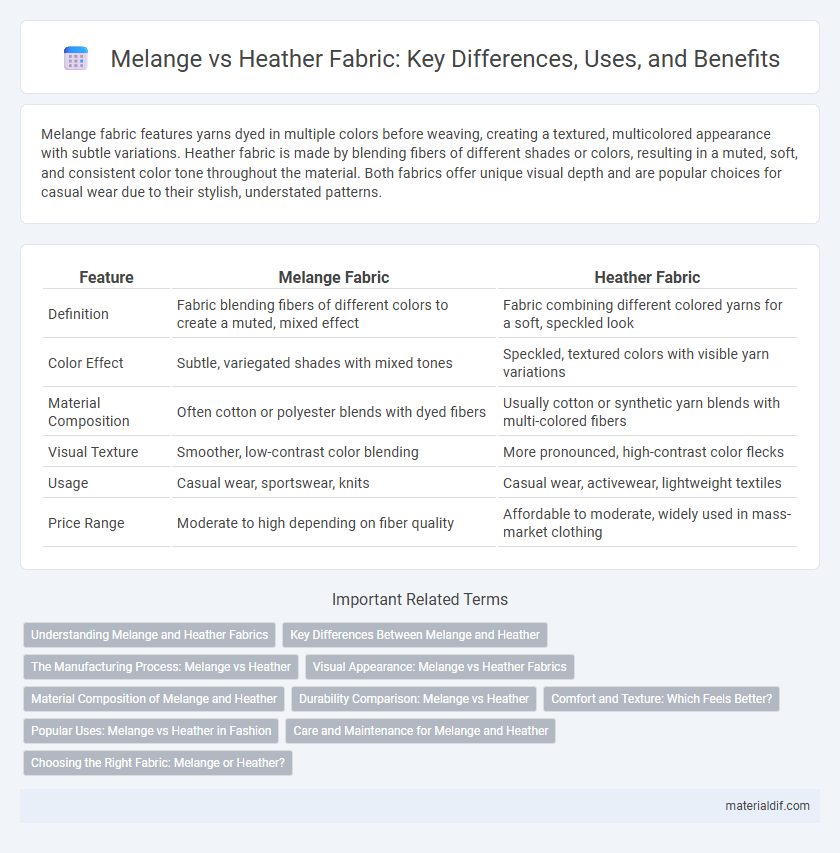Melange fabric features yarns dyed in multiple colors before weaving, creating a textured, multicolored appearance with subtle variations. Heather fabric is made by blending fibers of different shades or colors, resulting in a muted, soft, and consistent color tone throughout the material. Both fabrics offer unique visual depth and are popular choices for casual wear due to their stylish, understated patterns.
Table of Comparison
| Feature | Melange Fabric | Heather Fabric |
|---|---|---|
| Definition | Fabric blending fibers of different colors to create a muted, mixed effect | Fabric combining different colored yarns for a soft, speckled look |
| Color Effect | Subtle, variegated shades with mixed tones | Speckled, textured colors with visible yarn variations |
| Material Composition | Often cotton or polyester blends with dyed fibers | Usually cotton or synthetic yarn blends with multi-colored fibers |
| Visual Texture | Smoother, low-contrast color blending | More pronounced, high-contrast color flecks |
| Usage | Casual wear, sportswear, knits | Casual wear, activewear, lightweight textiles |
| Price Range | Moderate to high depending on fiber quality | Affordable to moderate, widely used in mass-market clothing |
Understanding Melange and Heather Fabrics
Melange fabric is created by blending fibers of different colors before spinning, resulting in a subtle, multicolored effect with a textured appearance. Heather fabric, often confused with melange, is made by mixing pre-dyed fibers or yarns during the knitting or weaving process, producing a soft, muted color with a slightly speckled design. Both fabrics offer unique visual depth and are popular in fashion and upholstery for their sophisticated, tonal variations.
Key Differences Between Melange and Heather
Melange fabric features fibers of different colors blended together before spinning, creating a subtle, mixed color effect with a smooth texture. Heather fabric is made by interweaving yarns of different shades or colors, resulting in a speckled or mottled appearance with a slightly rougher feel. Melange tends to have more uniform color blending, while Heather has a more distinct, patterned look due to the yarn variation.
The Manufacturing Process: Melange vs Heather
Melange fabric is created by spinning different colored fibers together before weaving, resulting in a unique, variegated pattern with depth and color complexity. Heather fabric is produced by blending fibers of different colors or shades during the yarn-dyeing process, giving a softer, more uniform mixed-color appearance. The key manufacturing difference lies in Melange's fiber-level combination versus Heather's yarn-level color blending, impacting texture and visual effect.
Visual Appearance: Melange vs Heather Fabrics
Melange fabrics showcase a distinct visual appeal through their subtle interwoven yarns of different shades, creating a speckled or mottled effect with a textured depth. Heather fabrics feature a more uniform, muted blend of colors that gives a soft, slightly faded look that is less contrasted than Melange. Melange tends to emphasize color variation and complexity, while Heather offers a smoother, consistent tone ideal for casual and athletic wear.
Material Composition of Melange and Heather
Melange fabric is created by blending fibers of different colors before spinning, often combining cotton and polyester for durability and softness. Heather fabric features interwoven yarns of mixed colors, typically using natural fibers like cotton or wool mixed with synthetic fibers for enhanced texture and strength. Both fabrics offer unique visual effects due to their fiber blends, but Melange focuses more on pre-spun fiber blending while Heather emphasizes yarn-level color mixing.
Durability Comparison: Melange vs Heather
Melange fabric, characterized by its blended yarns, typically offers enhanced durability due to the combination of fibers that increase resistance to wear and tear. Heather fabric, created by mixing different colored fibers before spinning, tends to have moderate durability but may show signs of fading or pilling faster than melange. Both fabrics provide aesthetic variety, but melange's fiber fusion makes it more resilient for long-term use in activewear and upholstery.
Comfort and Texture: Which Feels Better?
Melange fabrics blend multiple colored fibers, creating a soft, smooth texture that feels lightweight and breathable on the skin, ideal for comfort in everyday wear. Heather fabrics are made by mixing different colored yarns, resulting in a slightly rougher surface with a cozy, textured feel that retains warmth better. For superior softness and a gentle touch, melange fabric often provides a more comfortable experience, while heather excels in warmth and a tactile, textured vibe.
Popular Uses: Melange vs Heather in Fashion
Melange fabric, characterized by its blended yarns and subtle color variations, is popular in activewear and casual clothing due to its dynamic texture and modern aesthetic. Heather fabric, featuring a softer, muted appearance from interwoven fibers of different shades, is favored for cozy sweaters, tees, and loungewear that emphasize comfort and a vintage look. Both fabrics enhance fashion designs with distinct visual depth, but melange suits performance-oriented apparel while heather excels in relaxed, everyday wear.
Care and Maintenance for Melange and Heather
Melange fabric, made by blending different colored fibers before spinning, requires gentle washing in cold water and air drying to preserve its texture and prevent color fading. Heather fabric, created by combining dyed yarns during weaving, benefits from similar care but is often more durable, allowing for machine washing on a gentle cycle and low heat drying. Both fabrics avoid bleach and high heat to maintain their unique color patterns and fiber integrity.
Choosing the Right Fabric: Melange or Heather?
Melange fabric features a blend of multiple colored fibers spun together, creating a unique, multicolored appearance that adds depth and texture to garments. Heather fabric, on the other hand, combines different shades of the same color through yarn blending, resulting in a subtle, muted tone ideal for classic, versatile apparel. Choosing between melange and heather depends on the desired visual impact and fabric texture for specific clothing applications.
Melange vs Heather Infographic

 materialdif.com
materialdif.com